Stargazing

|
The Constellation Virgo |

|
- We now Spike to Spica. This is part of the Zodiac constellation Virgo.
{Trace out Virgo}. This is a faint constellation, close to the horizon
at this time of year and a little hard to see.
- Just above Virgo, if you look very hard, you can see a faint, wispy grouping
of stars that looks a bit like a tuft of hair. Can you see it? In fact that
is a star cluster, and together with the three nearby stars that form a right
triangle, they are the constellation Coma Berenices, or "Berenices Hair".
{Trace out Coma Berenices, showing the right-angle stand and the hair hanging
from it}. The cluster is a true family of stars that were formed together, and
it is "only" 250 light years away. This means that only the Ursa Major moving
group and the cluster that forms the face of the winter constellation Taurus
are closer to us.
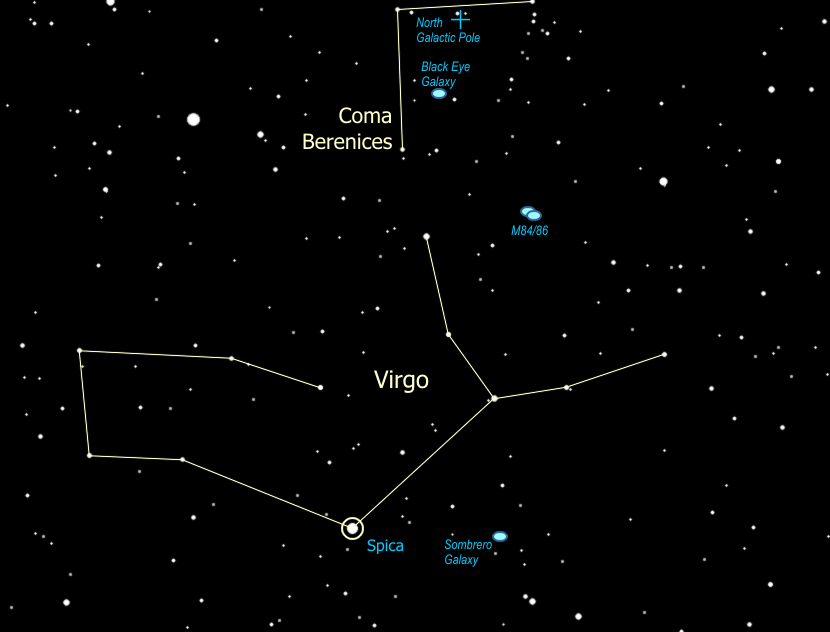
- You can see how the western stars of Virgo and Spica form a "Y" figure.
I see the "Y" as being her arms, although others see the 'left arm' as being
her head & Spica as her left hand holding a grain of wheat.
- I prefer to think of her arms outstretched holding the Virgo Cluster --
not a cluster of stars but rather a cluster of galaxies. The galactic pole
of our galaxy is right in Coma Berenices (you are looking up out of the disk)
and hence that is the best direction to see out of our galaxy and spot other
galaxies. The Virgo cluster is an actual cluster of galaxies (100 bright
galaxies, over 2,000 fainter ones), close to each other in space.
This region of interesting galaxies sweeps right up through Coma Berenices and is often called the "Virgo-Coma Cluster". One of the best is the Black Eye Galaxy, just to the left of that little star right there {point out 35 Comae}. You can spot it with the binoculars, although we need a relatively large telescope (8" or better) to see the black eye at the center. It's actually a lane of dust that is the result of a collision with another galaxy -- literally smacking into this one and leaving it with a black eye.
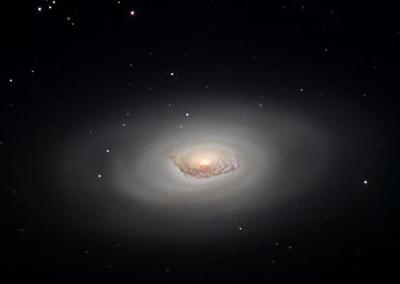
- I called Virgo a Zodiac constellation. What is a "Zodiac"
constellation?
As the earth goes around the sun, this motion means that every day we look back at the sun in a slightly different direction, with different stars behind it. The sun appears to move through the constellations. Theoretically there are twelve constellations through which the sun moves, one per month, and these are the Zodiac constellations. In reality there is a 13th constellation through which the sun passes (technically at least) and it gets no credit for being in the Zodiac - Ophiuchus.
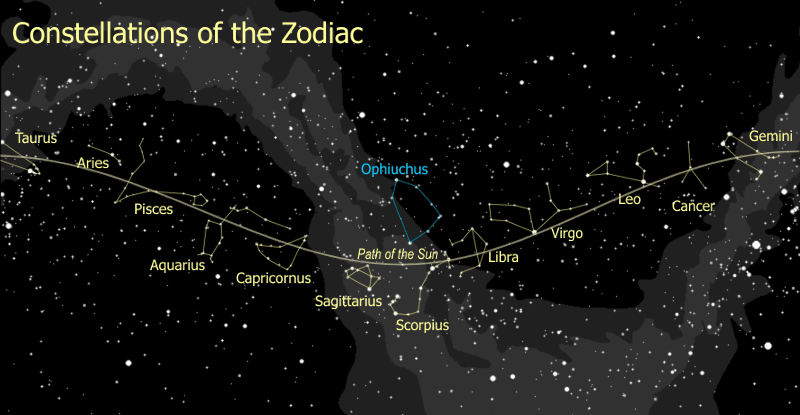
- Clearly the brightest star in Virgo is Spica. Which
do you think is brighter, Spica or Arcturus? Which is brighter, Spica or
Polaris?
Astronomers measure star brightness using 'magnitudes' -- Arcturus has a magnitude of 0, Spica has a magnitude of 1, Polaris has a magnitude of 2. As magnitude number goes up, brightness goes down. A magnitude 1 is 2½ times as bright as a magnitude 2, a 2 is 2½ times as bright as a 3, and so on.
This comes from the system set up by ancient Greeks, where the brightest stars were stars of the first magnitude, like 'first class', and the faintest stars you could see were stars of the sixth magnitude. When astronomers got telescopes and instruments that could measure star brightness, they found 1st magnitude stars were almost exactly 100 times the brightness of 6th magnitude stars. That works out to a factor of 2½ from one magnitude to the next.
Magnitudes can go negative for stars brighter than 0 magnitude Arcturus. The brightest star in the sky is Sirius (in the winter sky), which has a magnitude -1.5.
Well, what's really the brightest star in the sky? The sun has a magnitude of -27.
- You can use the cup of Little Dipper to gauge how good your
sky is... the clearer the sky, the fainter the magnitudes you can see.
The North Star, at the tip of the handle, is magnitude 2, as is the next brightest
star at the tip of the cup β Ursa Minoris) -- also
magnitude 2. The other star at the end of the cup is magnitude 3. The star
where the handle joins the cup is magnitude 4, and the other star at the back
of the cup is magnitude 5. You can only see the magnitude 5 when the sky is
very clear and very dark. Exactly half-way between the magnitude 4 and 5 is a
magnitude 6, at the limit of what most people can see. You may need to use
"averted vision" to see it -- look at the first star of the handle and, as you
look away from the cup, you can see the faint magnitude 6 star at the back of
the cup, the sign of an exceptionally clear and dark sky. The Little Dipper
test works best in the summer when the Little Dipper is highest in the sky.
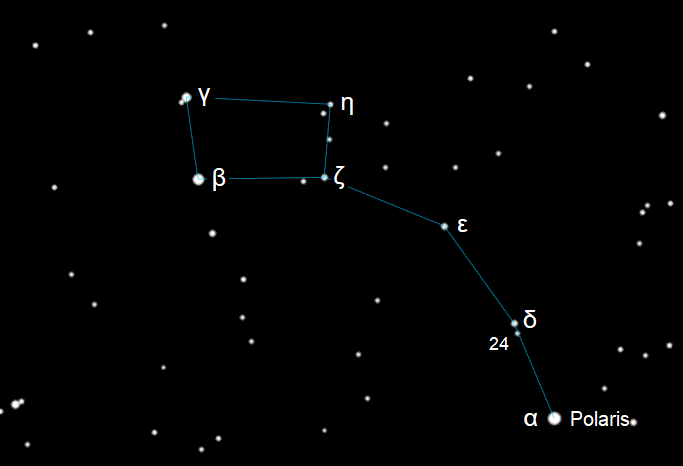
- It's not only the brightness of each star that is different.
Can you see a difference in color between Spica and Arcturus? Look at Arcturus
and tell me what color that might be. It's more yellow than Spica, isn't it?
Spica is more of a blue color. That very bright star to the south is Antares
(part of the constellation Scorpius). The name
"Antares" is from Greek and means "rival of Mars". Can you see why? It's every
bit as red as Mars, isn't it? So what do the star colors mean? Why would one
star be blue and another red?
Yup, that's right. Different colors show different temperatures. So which star color is the hottest? Just like a flame, blue is the hottest part, yellow is next, red is the coolest. The sun is a yellow star, about 10,000°F at the surface. A red star is about half the sun's surface temperature, whereas a blue star is three to five times as hot as the sun. White stars are somewhere between the yellow ones and blue ones.
Now, all stars are made of pretty much the same stuff -- about 90% hydrogen and the rest is helium with some traces of other stuff. So, why would one star be burning hotter than another? The answer is in the size of the star. The more massive it is, the more pressure there is at the center and therefore the hotter - and for that matter the brighter - the star burns. So blue stars are the biggest and brightest of stars, and red stars are the smallest and dimmest.
So why is red Antares so bright? Hmmm... yeah... well, like with most rules, there are exceptions to the rule, and this rule is no exception. Antares is a star that is literally running out of gas. As a star burns up all the hydrogen at its center, it starts to burn helium (which is the "ash" from the hydrogen burning), which makes it expand, get brighter, and turn red -- it becomes a red giant. This is the time you can get a bright red star, when the star is near the end of its life.
When our sun starts burning out it will expand so big it will swallow up Mercury and Venus and scorch the surface of the earth to a cinder. If you are hoping to see all that happen you will have to wait about 5 billion years.
So there are two reasons a star could be red -- it is massive (and once was yellow, white or even blue) and is now burning out (a red giant), or it never had enough mass to burn any hotter than red (a red dwarf).
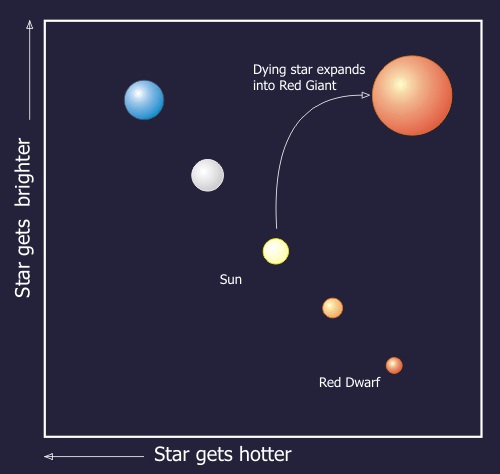
Notice that when we graph out the stars showing their temperature (or color) against their brightness, most of them fall along a line -- this line is called the Main Sequence, and the graph is called the "H-R" (for Hertzsprung-Russell) Diagram. Others are not on the main sequence, mostly stars that are either just being born (called "T-Tauri" stars) or stars that are near the end of life.
 |
 |
 |
| Back to Boötes | Go to Summer Index | On to Cepheus |
Questions
Your questions and comments regarding the Stargazing section are welcome.
You can e-mail the author, Randy Culp for inquiries,
suggestions, new ideas or just to chat.
Updated 18 July 2023
